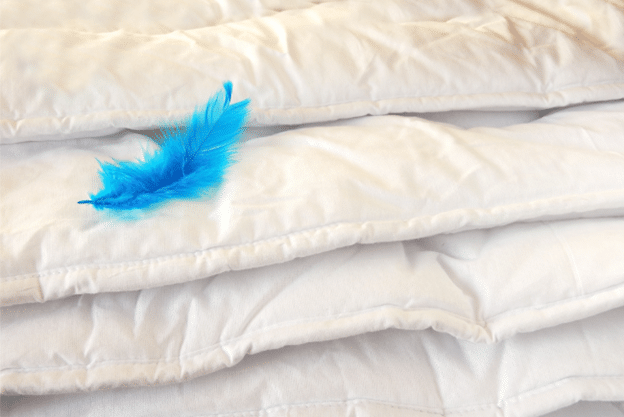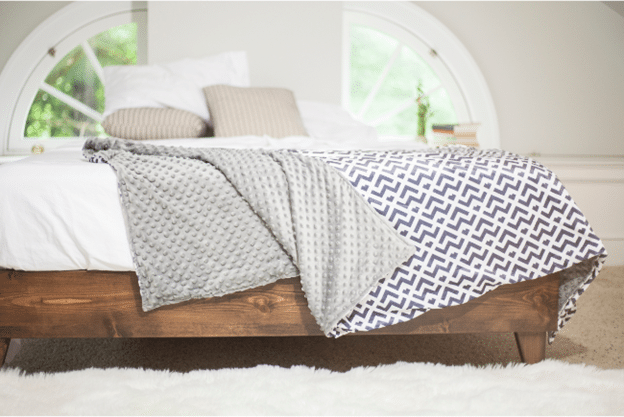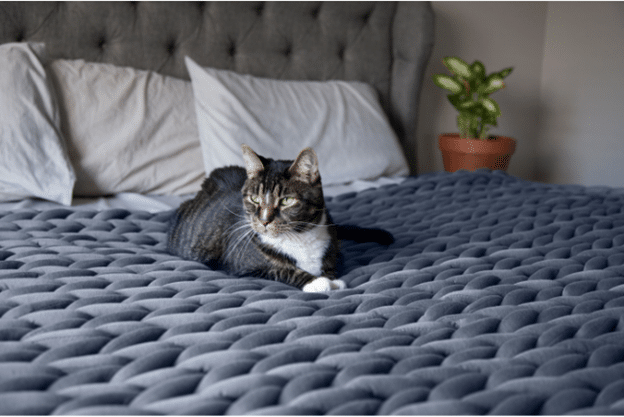Table of Contents
Weighted blankets have become increasingly popular over the last few years as an alternative therapy for anxiety, insomnia, and other conditions. But how exactly do they work? Who can benefit from them? And what should you know if you’re considering buying or making your own weighted blanket? This ultimate guide covers everything you need to know.
How Weighted Blankets Work?
Weighted blankets provide “deep pressure stimulation,” which can have a calming, comforting effect, similar to swaddling or getting a hug. The weight – often between 5 and 30 pounds – pressing down on the body lightly activates pressure points and mimics the feeling of being held or cuddled. This stimulation increases serotonin and melatonin production while decreasing cortisol levels, resulting in a relaxed, calmer state.
The blankets are filled with materials like plastic poly pellets or glass beads distributed evenly throughout internal pockets or squares in the blanket. This even weight distribution is critical – it should feel like a gentle, full-body hug, not heavy in one spot. The deep pressure stimulation works best when the weight is around 10% of your body weight.
Benefits of Weighted Blankets
There are many potential benefits associated with using weighted blankets, particularly for sleep, anxiety, ADHD, and more:
1. Improves Sleep:
The deep pressure stimulation increases serotonin and melatonin, making falling and staying asleep easier. Studies have found that over 65% of people report improved sleep using weighted blankets.
2. Reduces Anxiety:
The calming effect of the deep pressure has been shown to significantly reduce anxiety symptoms, both mentally and physically, from racing thoughts to rapid heartbeat.
3. Increases Focus for ADHD:
Some research suggests weighted blanket use can boost the production of dopamine and increase focus for those with ADHD. The comforting pressure allows the mind to calm so it can better concentrate.
4. Provides Pain Relief:
Early research shows that weighted blankets may help reduce chronic pain like fibromyalgia by using deep pressure to distract the brain from pain signals. However, more studies are still needed in this area.
5. Promotes Relaxation:
The overall calming result of using cooling weighted blankets promotes relaxation, whether winding down for sleep or seeking comfort during stressful, overwhelming situations during the day.

Choosing the Right Weighted Blanket
If you’re considering a weighted blanket, it’s essential to choose the right one tailored to your needs and situation.
1. Weight:
Choose a blanket around 7-12% of your body weight. Any heavier blanket could feel oppressive; any lighter and you lose the profound pressure stimulation benefits.
2. Size:
Choose a blanket that fully covers your body for maximum effectiveness. A 36″x48″ or 41″x60″ for twin beds and single sleepers works well.
3. Filling:
The most common blanket fillings are plastic poly pellets or glass beads. Glass beads mold better to your shape, but plastic pellets last longer over time. Consider any noise or texture preferences as well.
4. Fabric:
Choose a natural, breathable fabric like cotton so the blanket doesn’t get overly warm. Ensure the inner fill is secured safely in quilted squares.

5. Care:
Check that the blanket filling is evenly distributed and the fabric is durable enough for daily use and regular washing. Following all care instructions is essential.
Using Weighted Blankets Safely
While weighted blankets are generally considered safe, following certain precautions is still essential:
1. Use the Correct Weight:
To avoid injury or discomfort, follow the 10% body weight rule when choosing the proper density. Doing so ensures the deep pressure is therapeutic, not painful or restrictive.
2. Don’t Use Full-time:
Rest with the blanket for less than an hour, taking regular breaks to prevent overheating or discomfort over extended periods.
3. Proper Positioning:
Make sure no area of skin or limbs ever feels “pinched” under the weight. And don’t wrap the blanket tightly around yourself as you would a regular blanket.
4. Supervise Children:
Don’t leave weighted blankets with babies or toddlers unsupervised. Children benefit at much lower weights relative to body size. Monitor use.
Following basic guidelines like these helps minimize risks and ensures you fully reap the relaxation and health perks provided by weighted blankets when used thoughtfully.
DIY Weighted Blankets
Looking to save money by making your own weighted blanket at home? Here’s a step-by-step guide:
Step-by-Step Guide
- Choose your base fabric, likely soft cotton, flannel, or Minky, around 36″ x 48″ or oversized. Avoid slippery fabrics.
- Decide on a pattern you’d like the squares sewn in, and use fabric markers to draw quilt lines.
- Sew together the quilt lines, leaving one side open per square to stuff later.
- Calculate how much polyfill stuffing you need. About 120 pellets/beads per square inch work well.
- Carefully stuff each open square, distributing fill evenly. Overfill slightly to allow for settling.
- Seal all open squares by hand or machine, and sew the remaining openings carefully closed.
- Make sure no leaks of escaping fill exist in any squares’ stitching. Thoroughly check for holes.
- Wash and dry the blanket on a delicate cycle before first use according to fabric recommendations.
- Enjoy! Adjust fill levels per square as needed over time.
Safety Precautions
When making your own weighted blanket:
- Avoid small/sharp filler materials that could poke through the fabric
- Ensure all seams and stitching are sturdy and allow no leakage
- Check that filler amount per square aligns with 10% of body weight rules
- Use child-safe materials if making kids’ DIY weighted blankets
- Don’t give DIY weighted blankets to infants or young toddlers
With time and care, you can craft an effective weighted blanket that provides years of soothing comfort.
Conclusion
Weighted blankets provide deep pressure stimulation that can comfortingly calm both body and mind. From easing anxiety to improving sleep and focus, their benefits are wide-ranging while being gentle and safe when basic precautions are followed.
If you want to incorporate weighted blankets into your daily wellness routine, prioritize choosing options with weights around 10% of your body weight and sizes big enough to fully cover you. And now you can even DIY your own at home with some simple sewing skills for a more affordable option.
Give yourself the gift of cozy, calming comfort with the addition of a weighted blanket this season. Your mind and body will thank you through reduced stress, better sleep quality, and a sense of soothing peace.


